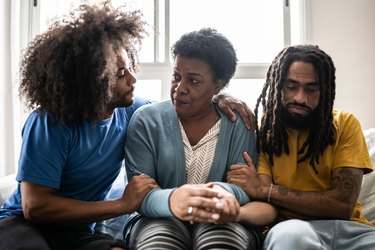
Big emotions are a rite of passage for toddlers and preschoolers, and kids of any age might struggle through stressors like the death of a grandparent or watching their parents go through a divorce. But it can be tough to tell what is developmentally appropriate and what might indicate an underlying mental health concern.
It can also be difficult to figure out at what age a child should see a therapist. But in general, experts say, the youngest age for therapy is around 3.
Video of the Day
Video of the Day
"If they're younger than that, their language skills usually aren't solidified, which can make it tricky," explains David Palmiter, PhD, a psychology professor at Marywood University in Scranton, Pennsylvania.
After that, kids are usually able to verbalize and understand enough to make therapy worthwhile.
Mental health issues in kids are relatively common: In fact, almost 15 percent of children ages 5 to 17 have received mental health treatment in the last 12 months, including 11.5 percent who received counseling or therapy from a mental health professional, according to June 2023 data from the Centers for Disease Control and Prevention (CDC).
But therapy for your 5-year-old looks very different than what you may be used to. Here's a guide to the most common types of therapy used with kids, plus tips on how to talk to kids about therapy and find the right therapist for your child.
Types of Therapy for Kids
There are two main types of therapy used with children: play therapy and cognitive behavior therapy (CBT). Here's a closer look.
Play Therapy
For very young children, this type of therapy is usually best. This involves the use of things like toys, blocks, dolls, puppets, drawings and games to help your child talk about how they feel.
"We focus on non-directive play therapy, which means the child is essentially in charge of the session," explains Laurie Zellinger, PhD, a child psychologist in Cedarhurst, New York.
"They choose the activities and the toys. The kids are encouraged to make noises and messes, and it's made clear they don't have to clean up. The theory is that play is a child's language, and toys are their words."
Preliminary research backs this up: A small September 2020 pilot study in Child Abuse & Neglect found kids in a domestic violence shelter who participated in one to two hours of group play therapy a week for 12 weeks reported significant reductions in symptoms of depression and post-traumatic stress disorder.
"Over time, we use a combination of talk and play to help kids better understand and manage their feelings and behavior," Zellinger says.
Therapists will often have parents sit in, at least for the first few sessions. "It really can help us see into the inner world of a child," explains Andrea Corn, PsyD, a child psychologist in Boca Raton, Florida.
Recently, Dr. Corn did a session where she played the game Chutes and Ladders with a 3-year-old child and his mother. "His parents were in the midst of a divorce, and what struck me is that the child would not let his plastic figurine be in a different square from his mother," she recalls.
She also has a slew of puppets, including cats, butterflies, sharks and alligators. "If a child consistently picks aggressive animals, like sharks, to talk about their home life, it gives me insight as to where conflict is coming from," she says.
Cognitive Behavior Therapy
CBT is often recommended for older kids and teens. It focuses on changing thoughts and emotions that can cause unwanted behavior in kids. The first step is to help a child become aware of their thoughts and feelings, then the therapist guides them through the process of changing those thought patterns, according to the CDC.
Research suggests CBT can help reduce symptoms of depression in kids and teens, especially if their parents are involved, according to a January 2019 review in the Journal of European Psychiatry.
"I use it often to help with a specific task — for example, to help a kid sleep better, or who has an intense phobia of say, spiders," Zellinger says. "Usually, I have them create a hierarchy from 1 to 10 of the things they're most afraid of and help guide them through each of those steps."
It can also be used in younger kids, she notes, along with play therapy. "Recently, I had a child who was afraid of throwing up," she recalls. "We created fake vomit and got her to make throw-up noises. It made her laugh, which helped her overcome her fears."
CBT is often most effective when parents get involved, too, Palmiter says. "One of my top ways to help manage depression and anxiety in kids is to have them develop a list of things that make them feel good about themselves," he explains. "It could be their parents, their favorite movie or song or even a favorite food. We then put these items in a binder — we have pictures of them, if kids can't read yet — and coach parents on how to use it to help their child manage their emotions."
Tip
Another type of therapy often used in younger children is Parent-Child Interaction Therapy or PCIT. “In these situations, a parent and their child play or otherwise interact together while the therapist provides in-the-moment coaching,” Zellinger says.
What to Look for in a Therapist for Kids
When you're shopping for a therapist for young kids, the most important thing is to make sure their practice truly focuses on children, not adults, Zellinger says. "You want someone who is knowledgeable about child development and various play therapy techniques, so that they can tailor therapy to your child," she says. "You don't want someone who just uses the same CBT approach with each kid."
You may, however, find that to be a challenge. There's a nationwide shortage of mental health professionals: In fact, by 2025, there could be 10,000 fewer therapists than needed in a number of different mental health specialties, according to estimates from the Department of Health and Human Services.
Asking trusted professionals for recommendations and searching existing databases can help. Here are a few ways to find a therapist:
- Through your pediatrician
- Through your child's school guidance counselor
- Through your local children's medical center
- Via the American Psychological Association's psychologist locator
- Via the American Academy of Child & Adolescent Psychiatry's psychiatrist finder
How to Talk to Your Child About Going to Therapy
The way you explain therapy to your 3-year-old will be very different from the way you explain it to an older child or teen.
For a very young child, keep it simple: "Say to them, 'Sometimes you can't express your feelings like you want to,'" Dr. Corn recommends. "'We are taking you to see a 'feelings' doctor to help you figure out what bothers you, and if you're sad or mad or both.'"
It may help to compare it to another scenario they've gone through recently, such as when they fell and hurt their head and had to see their pediatrician for treatment, for example. "You can say, 'That doctor used stitches, but this doctor uses games and playing to help you,'" she says.
But it's best to play it straight with older kids and teens, Dr. Corn says. Explain to them that you've noticed they seem sad, anxious or depressed, and that you want to give them the help they need so they don't have to continue to live this way.
You may encounter some resistance at first, but continue to encourage them to go to therapy, and be supportive when they do. Remember, you can ask how a session went, but don't shower older kids or teens with questions or demand to get all the details from their therapist.
"You don't expect to know everything that happens in your child's classroom, and the same holds true for therapy," Dr. Corn says. As long as your child progresses, trust in the process.
- CDC: "Mental Health Treatment Among Children Aged 5–17 Years: United States, 2021"
- Child Abuse & Neglect: "Trauma-informed art and play therapy: Pilot study outcomes for children and mothers in domestic violence shelters in the United States and South Africa"
- Journal of European Psychiatry: "Effectiveness of CBT for children and adolescents with depression: A systematic review and meta-regression analysis"
- Department of Health and Human Services: "National Projections of Supply and Demand for Selected Behavioral Health Practitioners: 2013-2025"
- CDC: "Therapy to Improve Children’s Mental Health"
Is this an emergency? If you are experiencing serious medical symptoms, please see the National Library of Medicine’s list of signs you need emergency medical attention or call 911.


